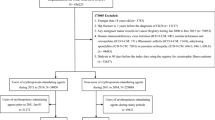Abstract
Summary
Several differences may have existed between patients treated with peritoneal dialysis and hemodialysis because of the difference in dialysis modality. This nationwide population-based cohort study demonstrated that patients on hemodialysis had an increased risk of hip fracture compared to patients on peritoneal dialysis; the hazard ratio was 1.52.
Introduction
Numerous debates on which dialysis modality is “superior” have taken place in recent decades. However, no large-scale study has ever mentioned about the relationship between dialysis modality and risk of hip fracture.
Methods
We identified 64,124 incident end-stage renal disease patients from the National Health Insurance Research Database in Taiwan between 1998 and 2008, including 59,457 (92.72 %) hemodialysis (HD) and 4,667 (7.28 %) peritoneal dialysis (PD) patients. After 8:1 propensity score matching, 31,554 patients, of whom 28,048 were HD and 3,506 were PD patients, were included in the study. We conducted the Cox proportional hazards model to examine the effects of dialysis modality and other variables on hip fracture risk.
Results
A total of 2,587 hip fractures were identified in 64,124 dialysis patients. The incidence rate of hip fracture was 13.60 per 1000 patient-years in the HD group and 6.25 in the PD group. Dialysis modality, sex, age, presence of cardiovascular disease, diabetes, medication with antiepileptic drugs, diuretics, steroids, and vitamin D had statistically significant associations with hip fracture. Patients on HD had an increased risk of hip fracture compared to patients on PD; the hazard ratio (HR) was 1.52 (95 % CI: 1.09–2.12, P = 0.02).
Conclusions
In this population-based cohort study, HD had a greater hip fracture risk compared to PD; the HR was 1.52. We should focus more on reducing the risk of hip fractures in hemodialysis patients.
Similar content being viewed by others
References
Cummings SR, Melton LJ (2002) Epidemiology and outcomes of osteoporotic fractures. Lancet 359:1761–1767
West SL, Lok CE, Jamal SA (2010) Fracture risk assessment in chronic kidney disease, prospective testing under real world environments (FRACTURE): a prospective study. BMC Nephrol 11:17
Coco M, Rush H (2000) Increased incidence of hip fractures in dialysis patients with low serum parathyroid hormone. Am J Kidney Dis 36:1115–1121
Grassmann A, Gioberge S, Moeller S, Brown G (2005) ESRD patients in 2004: global overview of patient numbers, treatment modalities and associated trends. Nephrol Dial Transplant 20:2587–2593
Leonard MB (2009) A structural approach to skeletal fragility in chronic kidney disease. Semin Nephrol 29:133–143
Parfitt AM (1998) A structural approach to renal bone disease. J Bone Miner Res 13:1213–1220
Wang YH, Kung PT, Tsai WC, Tai CJ, Liu SA, Tsai MH (2012) Effects of multidisciplinary care on the survival of patients with oral cavity cancer in Taiwan. Oral Oncol 48:803–810
Leinau L, Perazella MA (2006) Hip fractures in end-stage renal disease patients: incidence, risk factors, and prevention. Semin Dial 19:75–79
Alem AM, Sherrard DJ, Gillen DL, Weiss NS, Beresford SA, Heckbert SR, Wong C, Stehman-Breen C (2000) Increased risk of hip fracture among patients with end-stage renal disease. Kidney Int 58:396–399
Stehman-Breen CO, Sherrard DJ, Alem AM, Gillen DL, Heckbert SR, Wong CS, Ball A, Weiss NS (2000) Risk factors for hip fracture among patients with end-stage renal disease. Kidney Int 58:2200–2205
Shao CJ, Hsieh YH, Tsai CH, Lai KA (2009) A nationwide seven-year trend of hip fractures in the elderly population of Taiwan. Bone 44:125–129
Gayat E, Resche-Rigon M, Mary JY, Porcher R (2012) Propensity score applied to survival data analysis through proportional hazards models: a Monte Carlo study. Pharm Stat 11:222–229
Becker C, Crow S, Toman J, Lipton C, McMahon DJ, Macaulay W, Siris E (2006) Characteristics of elderly patients admitted to an urban tertiary care hospital with osteoporotic fractures: correlations with risk factors, fracture type, gender and ethnicity. Osteoporos Int 17:410–416
Brown JP, Josse RG (2002) 2002 clinical practice guidelines for the diagnosis and management of osteoporosis in Canada. CMAJ 167:S1–S34
Chen HF, Ho CA, Li CY (2008) Increased risks of hip fracture in diabetic patients of Taiwan: a population-based study. Diabetes Care 31:75–80
Nguyen ND, Pongchaiyakul C, Center JR, Eisman JA, Nguyen TV (2005) Identification of high-risk individuals for hip fracture: a 14-year prospective study. J Bone Miner Res 20:1921–1928
Rejnmark L, Vestergaard P, Mosekilde L (2006) Fracture risk in patients treated with loop diuretics. J Intern Med 259:117–124
Taylor BC, Schreiner PJ, Stone KL, Fink HA, Cummings SR, Nevitt MC, Bowman PJ, Ensrud KE (2004) Long-term prediction of incident hip fracture risk in elderly white women: study of osteoporotic fractures. J Am Geriatr Soc 52:1479–1486
Freitas C, Fructuoso M, Martins LS, Almeida M, Pedroso S, Dias L, Henriques AC, Cabrita A (2011) Posttransplant outcomes of peritoneal dialysis versus hemodialysis patients. Transplant Proc 43:113–116
Guo CH, Wang CL, Chen PC, Yang TC (2011) Linkage of some trace elements, peripheral blood lymphocytes, inflammation, and oxidative stress in patients undergoing either hemodialysis or peritoneal dialysis. Perit Dial Int 31:583–591
Rysz J, Stolarek RA, Pedzik A, Nowicki M, Nowak D (2010) Serum antioxidant capacity is preserved in peritoneal dialysis contrary to its robust depletion after hemodialysis and hemodiafiltration sessions. Ther Apher Dial 14:209–217
Elder GJ, Mackun K (2006) 25-Hydroxyvitamin D deficiency and diabetes predict reduced BMD in patients with chronic kidney disease. J Bone Miner Res 21:1778–1784
Pelletier S, Vilayphiou N, Boutroy S, Bacchetta J, Sornay-Rendu E, Szulc P, Arkouche W, Guebre-Egziabher F, Fouque D, Chapurlat R (2012) Bone microarchitecture is more severely affected in patients on hemodialysis than in those receiving peritoneal dialysis. Kidney Int 82:581–588
Acknowledgments
This study is based on the data from the National Health Insurance Research Database provided by the Bureau of National Health Insurance, Department of Health, Taiwan. This work was supported by China Medical University and Asia University (grant numbers CMU99-ASIA-18 and DOH101-TD-B-111-004).
Conflicts of interest
None
Author information
Authors and Affiliations
Corresponding author
Rights and permissions
About this article
Cite this article
Chen, YJ., Kung, PT., Wang, YH. et al. Greater risk of hip fracture in hemodialysis than in peritoneal dialysis. Osteoporos Int 25, 1513–1518 (2014). https://doi.org/10.1007/s00198-014-2632-6
Received:
Accepted:
Published:
Issue Date:
DOI: https://doi.org/10.1007/s00198-014-2632-6




